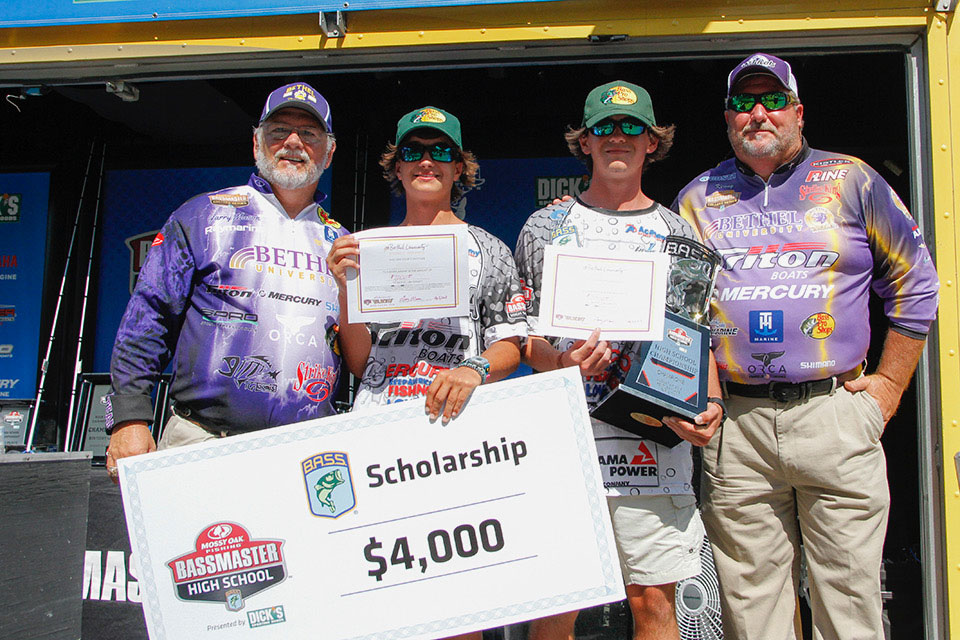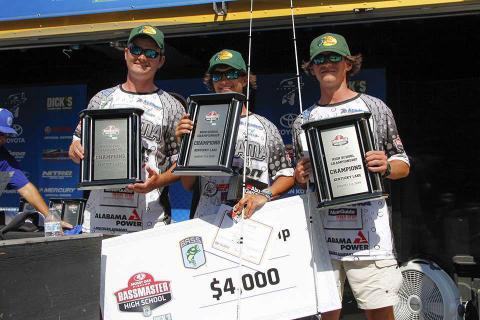“I’ve been bass fishing my whole life,” said 16-year-old high school junior, Tucker Smith, the other half of 2018 Mossy Oak Bassmaster High School Series National Championship team from Briarwood Christian High School in Birmingham, Alabama. “My uncle, Robbey Stanford, and grandfather, Bo Stanford, have taken me fishing most of my life. My dad likes to fish, but he’s really not into it as much as my uncle and my granddad. Fishing always has been my passion. I’ve played baseball and football but thought my competing in bass fishing and possibly getting money for scholarships to go to college was cool. Grayson [Morris] and I like to fish together and have for a number of years. We decided to partner for the Briarwood team. Once we started fishing together, our partnership seemed to work, and we saw no reason to change.”

Smith (second from the left) is a bladed jig fisherman and has fished the bladed jig for as long as he can remember. Many of Alabama lakes where he lives and fishes have off-color water, and he feels he’s been more successful with bladed jigs to catch bass than any others he fishes. Smith’s favorite bass-fishing colors are black-and-blue, pumpkin and all-white. Smith cast an all-white bladed jig during the High School National Championship. His favorite bladed jig is the Z-Man-Jackhammer.
“This is a new bladed jig that’s pricey at $17.99 each. However, I think the quality of the lure justifies the price,” said Smith. “It’s hand-tied, has a very strong hook and has a really good blade and swivel combination.”
Smith decided to fish the white bladed jig because the bass were feeding on white-bellied gizzard shad in the back of the creek.
Every two-person high school team is required to have a boat driver. The team of Morris and Smith chose J.T. Russell as their boat captain, who’s a student at the University of Montevallo in Alabama and competes on the college level there. During practice, the Briarwood Christian team discovered a lane they could run through - a 500-yard flat - without hitting any underwater stumps or logs.
“Getting into the creek was pretty scary because the propeller on the motor was practically the only part of the boat in the water,” Smith remembers. “The first time we ran across the flat to get into the back of the creek, I could see bushes and trees to both the left and right sides of the boat, and I held on for dear life.”
Smith and Morris set up as a two-angler fishing team, with Smith fishing the faster-moving bladed jig on the front of the boat, casting into the bushes and trees. At the same time, Morris was on the back of the boat, flipping, pitching and skipping his jig into the thicker part of the cover.
“We found a few sweet spots where we could catch bass besides in the very back of the creek where the spring was coming in, but honestly we didn’t think that spot could continue to produce bass for all three tournament days,” Smith explained.
However, much to Smith and Morris’s surprise, bass continued to move into the spring regularly in almost unbelievable numbers. The Briarwood team had several spots in the creek where they were catching bass, but not until the last day of the tournament did they decide to put heavy fishing pressure on the spring.
“We’d go to the spring about every 30 minutes to an hour, and every time we’d start fishing the bladed jig and a jig around the spring, we’d catch a bass that weighed 3 pounds or more,” Smith said.
The last day of the tournament, the water in the creek started falling, so more and more of the bass holding in the creek moved toward the spring. The first two days of the tournament five or six other teams had fished that same creek. However, on the final day when the field was cut to 12 teams, Morris and Smith didn’t have any company in their creek. One of the memorable events during the tournament, according to Smith was on the second day of the tournament when they returned to the spring and saw another team fishing it.
“That other team sat on the spring and fished it hard for about 1-1/2 hours,” he said. “Once they finally stopped fishing the spring and turned their boat to fish out in the creek, Grayson and I pulled our boat up to the spring. The first cast I made with my bladed jig produced a 5-1/2-pound largemouth. Once the team that just left the spring saw our 5-1/2 pounder, they couldn’t believe the spring could produce a bass that size. After I caught that fish, we turned our boat around and started fishing down the same bank the other team was fishing. I caught a 3-1/2-pound largemouth right behind their boat that had just fished that same bank. Those fellows were so upset I thought they were going to throw their rods into the creek.”
Smith thinks that one of the advantages he had with his bladed jig was that he attached a 3-1/2-inch, paddle-tailed swimbait made by Reaction Innovations called a Skinny Dipper to it.
He mentions, too, that when he and his teammate weighed in their catch on the last day, his parents cheered so loudly that they both lost their voices. Smith has two more years to compete on Briarwood’s high school bass fishing team, and his plans after high school graduation are to go to college and compete in the Bassmaster College Series. Besides the trophies and awards that Smith and Morris won, they each also received scholarships from Bethel University for $28,000 for 4 years of college, and $2,000 worth of scholarships each to any college they want to attend from B.A.S.S. and Mossy Oak.
Learn more about High School Bass Fishing at https://www.bassmaster.com/high-school-bass-fishing



























